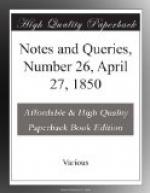“Dr. Burn, in his History of Westmoreland, would trace this crest of cuckoldom to horns worn as crests by those who went to the Crusades, as their armorial distinctions; to the infidelity of consorts during their absence, and to the finger of scorn pointed at them on their return; crested indeed, but abused.”—Todd’s Johnson’s Dictionary.
R.T.H.G.
Why Moses represented with Horns.—You may inform your querist “L.C.” (No. 24 p. 383.), that the strange practice of making Moses appear horned, which is not confined to statues, arose from the mistranslation of Exod. xxxiv. 30. & 35. in the Vulgate, which is to the Romanist his authenticated scripture. For there he reads “faciem Moysi cornutum,” instead of “the skin of Moses’ face shone.” The Hebrew verb put into our type is coran, very possibly the root of the Latin cornu: and its primary signification is to put forth horns; its secondary, to shoot forth rays, to shine. The participle is used in its primary sense in Psalms, xix. 31.; but the Greek Septuagint, and all translators from the Hebrew into modern European languages, have assigned to the verb its secondary meaning in Exod. xxxiv. In that chapter the nominative to coran is, in both verses, undeniably skin, not head nor face. Now it would obviously be absurd to write “his skin was horned,” so that common sense, and the authority of the Septuagint, supported by the language of St. Paul in his paraphrase and comment on this passage in 2 Cor. iii. 7-13., ought to have been sufficient to guide any Christian translator as to the sense to be attached to coran in the mention of Moses.
H.W.
Oxford, April 16, 1850.
[We have since received replies to a similar effect, from “SIR EDMUND FILMER,” “J.E.,” &c. “R.G.” refers our Querist to Leigh’s Critica Saera, part I. p. 219. London, 1662; and “M.” refers him to the note on this passage in Exodus in M. Polus’ Synopsis Criticorum. To “T.E.” we are indebted for Notes on other portions of “L.C.’s” Queries.]
The Temple or A Temple.—“Mr. Foss” says (No. 21. p. 335.) that in Tyrwhitt’s edition of Chaucer and in all other copies he has seen, the reading is—
“A gentil manciple was there of a temple.”
In an imperfect black-letter folio copy of Chaucer in my possession (with curious wood-cuts, but without title-page, or any indications of its date, printer, &c.), the reading is—
“A gentyl mancyple was there of the temple.”
That the above is the true reading ("the real passage"), and that it is to be applied to the temple, appears to me from what follows, in the description of the manciple.
“Of maysters had he moo than thryes
ten
That were of lawe expirte and curyous,
Of whyche there were a dosen in that hous
Worthy to be,” &c.;




